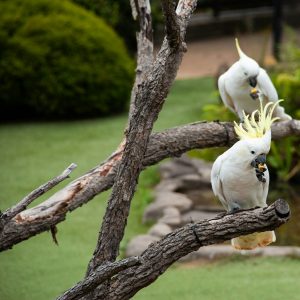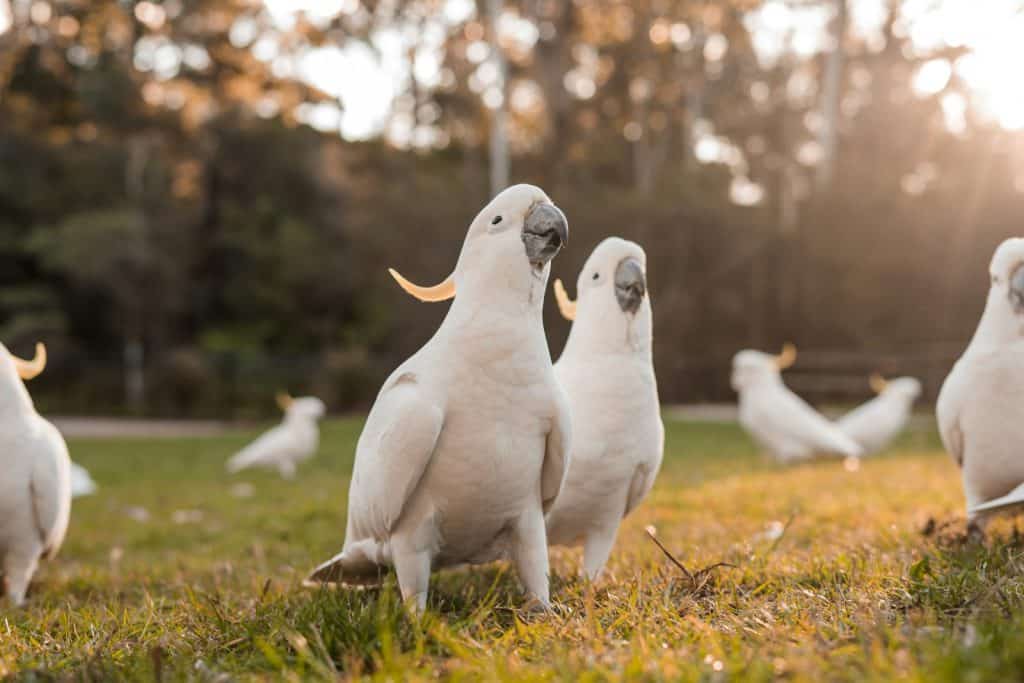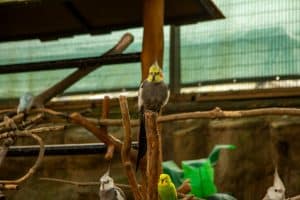For individuals new to these parrots, the comparison of cockatiel vs. cockatoo might be perplexing. After all, they appear similar (with a feather crest, hooked beak, and huge black eyes) and thrive in overlapping environments throughout Australia. However, there are some significant variations: cockatiels are considerably smaller, have longer tail feathers, and come in a variety of hues.
Is a cockatiel really a cockatoo, or is it something else? Discover all you need to know about the differences between cockatoos and cockatiels, as well as which would be a better fit for your family.
Are cockatiels members of the cockatoo family?
To really comprehend cockatiels’ place in the animal world, it’s crucial to remember that animals are classified into categories like classes, orders, families, subfamilies, and species.We can use these classifications to determine where this species fits on the tree and how close it is to cockatoos.
Cockatiels are birds belonging to the class Aves. Cockatiels belong to the Psittaciformes, or parrots, inside the avian category. They are a macaw family, the Cacatuidae (cockatoos), but they are an isolated subfamily within that clan: the Nymphicinae. They belong to the genus Nymphicus. The only species in the genus is Nymphicus hollandicus, which belongs to the macaw family.
Cockatiels were a difficult species to categorize. They’ve been grouped in a number of different (sub-)families, including the black cockatoos, before finally finding their home in the Nympicinae.
What does all this family and subfamily business imply? Cockatiels are, in fact, cockatoos. That’s not surprising, since they fulfill all of the criteria that set cockatoos apart from other parrots: they have a typical crest, dusty down feathers, no possibility of blue or green coloration, and feathers that cover the beak (Brown & Toft, 1999).
Despite their comparable features, it has been verified through molecular study that the cockatiels form a category of their own within the cockatoo family. The majority of cockatiels are members of the subfamily Cacatuinae (the exception are Calyptorhynchinae or black cockatoos). They reside on a different “tree branch” than cockatiels.
That is, a Moluccan cockatoo is more closely related to most other cockatoos, such as galahs or corellas, than it is to cockatiels. Cockatiels, on the other hand, are not distinct from real cockatoos. They’re simply a different sort of cockatoo that branches off the cockatoo family tree and has a separate origin, despite having descended from the same basic ancestor.
When an Australian parrot enthusiast discovered a cross between a galah cockatoo and a cockatiel in her aviary, she was shocked to find that the resulting offspring had white markings on its neck.
“World’s first galah breeds with cockatiel“
Cockatoo Overview
The Cockatoo is a small parrot that comes from Australia, Indonesia, and New Guinea. The various species of Cockatoos, such as the umbrella cockatoo and Goffin’s cockatoo, vary in size, but they all have brown feathers with white tips on their head and wings.
The Cockatoo is not one specific bird; it’s actually a family of birds made up of 21 different species. The snowy owl is easily identified by its beautiful fan of feathers atop their heads, and the vast majority have exceptionally long lifespans of up to 60 years in rare instances.
Cockatoo vs cockatiel: what are the differences?
Cockatiel vs Cockatoo is a difficult topic to define, and there are many nuances between the two. Let’s take a look at the most important distinctions! There are a lot of differences between cockatiel and cockatoo, much more than there are similarities. Cockatoos generally have larger body sizes and distinct behaviors compared to cockatiels. Let’s take a closer look at some of them!
Size
Cockatiels are the smallest of all non-parrot cockatoos, reaching a maximum size of about 12 inches (30 cm) from head to tail and weighing only 3.2 ounces (90 grams). The largest cockatoo on record is the black palm cockatoo (or goliath cockatoo, Probosciger aterrimus), which may reach a length of 24″ (61 cm) and weigh up to a kilo.
Appearance
Cockatiels and cockatoos have distinct appearances. Some of the most significant differences are as follows:
- Cockatiels have a lengthy tail, which is similar to that of parakeets. In fact, ‘tiel was formerly referred to as a parakeet and is still known as such in some languages. In Dutch, they are known as “falcon parakeets” (valkparkiet), while in German they are called “nymphensittich.”
- Cockatiels have a somewhat more delicate crest than other cockatoos.
- Cockatiels have distinctive yellow faces and orange cheek patches.
- Cockatiels have been selected to produce a wide range of hues (though, as previously stated, no green or blue cockatoos). Cockatoos are generally white, black, grey, or even pink. The latter is not seen in “tiels.”
If you compare them side by side, it might seem as if cockatiels and cockatoos are not closely related, but they are!
- SizeLadder shelf 7.48 x 7.48" / 19 x 19cm.
- Safe Material This bird corner perch is made of natural wood, non-toxic and harmless, pets can chew and bite safely, safely grinding teeth and trim beak and nails naturally, the perch surface polished smooth, will not hurt the pet feet.
- FeatureThe smooth and polished bird stand is made of solid materials, and the metal nut is more stable, which is convenient to install in any corner of the cage and increases the pet's activity space.
- Multi-FunctionThe playground for birds and parrots, the platform for resting, and the smooth surface protect the feet, making it a stable and safe landing site.
- Best GiftThis bird perch provides your pet with a nice and cozy place for playing, exercise and rest, relieves boredom and increases activity level, this is the perfect gift for pets.
Lifespan
Cockatiels, unfortunately, do not live as long as some other cockatoo species. Cockatiels live an average of 20 to 25 years in good circumstances, with the oldest “tiel” in the Guinness Book of World Records recorded to be 32 years old.
On the other hand, certain species of cockatoos can live for almost human lengths of time. Cookie the Major Mitchell’s cockatoo, who was listed in the Guinness Book as the world’s oldest cockatoo at age 82 in 2016, is a notable example. Other notable individuals include a Sulphur-crested cockatoo who apparently died at the age of 120 in 1916, and Fred, who blew out 100 candles (or ate 100 millet sprays?) in 2014.
However, it is worth noting that not all cockatoos live to be 100 years old. Certainly not by a long shot! Their lifespans, on the other hand, are vastly superior to those of the smaller cockatiels.
Behavior
Cockatiels and cockatoos are two distinct species of parrot that are often confused with one another. Cockatiels, which are smaller and more social than cockatoos, tend to be rather quiet, while cockatoos love to talk a lot. Some of the most notable distinctions between cockatiels and cockatoos may be found:
- Personality: Cockatiels are recognized to be some of the “coolest” parrot species. They dislike being manhandled, although they are sociable and enjoy being around their owners. In comparison with snugglebugs like cockatoos, which do not mind being handled at all if they are tame, compare that to lovebirds, which don’t like it when people touch them.
- Talking: Although you may teach your cockatiel to talk, it won’t have a huge vocabulary. Cockatoos, on the other hand, should be treated with great respect. Although their speech is frequently so raspy that only their owners comprehend what they’re saying, they can pick up words even if they’ve just heard them in passing.
- Noise level: COCKATOOES ARE NOISY. Their more talkative nature, on the other hand, comes with a considerably higher noise level. Cockatoo owners should pick up a pair of decent earplugs since they just adore to create as much noise as feasible in order to express their joy. Although cockatiels occasionally scream, they generally prefer to whistle and flock calls.
- Mental stimulation: Cockatiels are not as intellectually demanding as their larger cockatoo relatives; therefore, they do not require nearly as much mental stimulation to be cheerful and healthy. Although they do require a lot of out-of-cage time, tiels may be left to frolic about their playgrounds on their own for much of the day with ‘tiels. They’re not even cockatoos! To keep their active minds occupied, they need hours of instruction, toys, and puzzles.
Our tiny household cockatiels are even distantly related to the unusual and enormous black palm cockatoo.

Cockatiel vs cockatoo | What’s the difference?
Cockatiel vs cockatoo: which is best for you?
Without a doubt, a cockatiel is the most likely pet parrot species. They’re the second most popular pet bird breed (behind the budgerigar). Cockatoos generally are more difficult to handle than ‘tiels’ laid-back temperament, low noise levels, and tiny stature imply they are.
Cockatiels are less costly than cockatoos, and their cages and food are easy to come by. They’re also readily available in pet stores, and there are plenty of responsible breeders (and rescues needing homes). There’s more to it than simply choosing the cheapest option and having it available.
If you’re thinking about getting a cockatoo, keep in mind that their brains are comparable to those of a toddler’s, as is their noise level and desire for attention. You’re already out if you work eight hours a day unless you have multiple toos (which increases the noise and makes them less likely to bond strongly with you).
You’ll need a significant portion of your home to the bird’s cage, as well as more room for it to have fun out of its cage. Prepare yourself for several hours of time consuming activities, puzzles and toys (which will be destroyed without ceremony). Do you think you can have a peaceful Sunday afternoon watching television or sleeping in bed? Think again! Your bird will either become restless in its cage or attempt to get your attention by smashing into it.
All of this may sound bad, but it does not imply that I would not suggest a cockatoo to anybody: your ‘too might be your lifelong companion. It simply implies that I wouldn’t suggest a cockatoo to someone who doesn’t want to put in the effort required to build that bond, or anyone who can’t promise they’ll be able to keep a bird alive for 50 years.
All of this may sound bad, but it does not imply that I would not suggest a cockatoo to anybody: your ‘too might be your lifelong companion. It simply implies that I wouldn’t suggest a cockatoo to someone who doesn’t want to put in the effort required to build that bond, or anyone who can’t promise they’ll be able to keep a bird alive for 50 years.
Choosing the Right Pet Bird for You

When it comes to selecting a pet bird, many people gravitate towards popular pet birds like cockatiels and cockatoos. Both types offer unique characteristics, but it’s essential to understand their differences to find the best fit for your lifestyle.
Larger birds, such as cockatoos, can be more demanding in terms of care and attention. Their need for social interaction and mental stimulation often requires a significant time commitment. If you’re looking for a more manageable companion, a diminutive cockatiel might be the perfect choice. These small birds are not only easier to care for but also bring a lively and affectionate personality to your home.
Male Cockatiels: The Charming Companions
When considering cockatiels, many people opt for male cockatiels due to their vibrant colors and playful nature. Male cockatiels often exhibit more vocal behavior and can be trained to whistle and mimic sounds, making them delightful companions. Their social nature makes them ideal for families or individuals looking for an engaging pet bird.
Final Thoughts
Ultimately, whether you choose a cockatiel or a cockatoo, understanding their needs and characteristics is key to ensuring a happy, healthy environment for your new feathered friend. Both options can provide years of companionship, but it’s crucial to select the right bird for your home.





